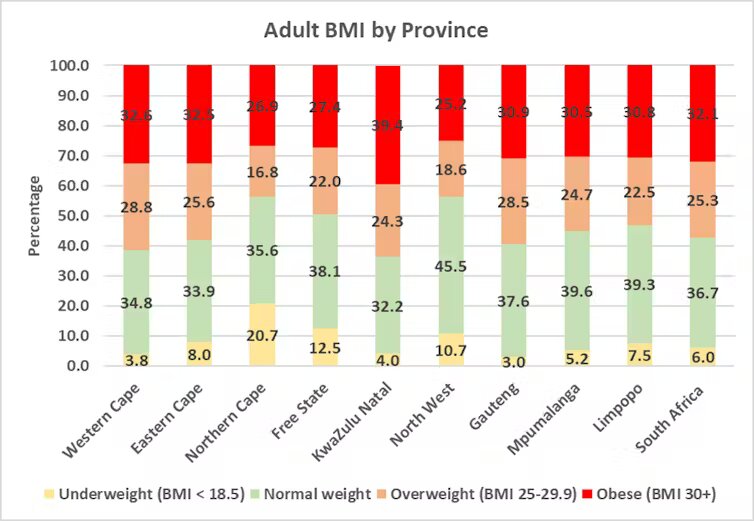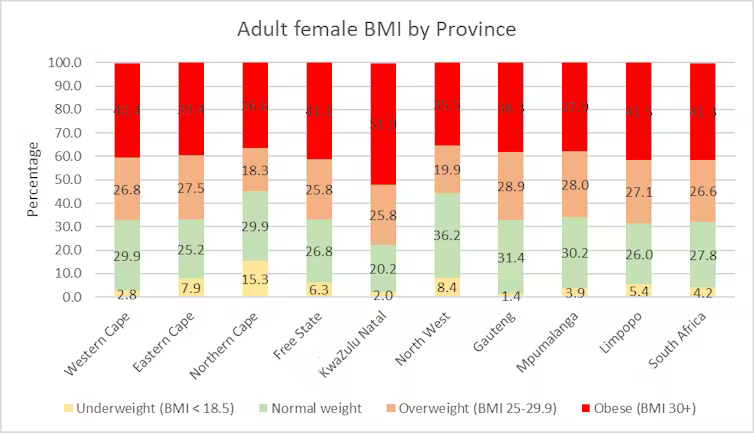In all its forms, malnutrition includes undernutrition (wasting, stunting, underweight), inadequate vitamins or minerals, overweight, and obesity.
South Africa has undergone a nutritional transition over the past 30 years characterized by the triple burden of malnutrition: households are simultaneously experiencing undernutrition, hidden hunger, and overweight or obesity due to nutrient-poor diets.
The results of the first in-depth, nationwide study into food and nutrition since 1994, the National Food and Nutrition Security Survey, found that almost half of South Africa’s adult population was overweight or obese.
While there was sufficient food to feed everyone through domestic production and imports, many families and individuals went to bed on empty stomachs.
Due to high unemployment figures, families relied on social grants to buy basic food items. Many tended to buy food with little nutritional value to avoid hunger.
The survey, conducted by the Human Sciences Research Council, was commissioned by the Department of Agriculture, Land Reform, and Rural Development to map the country’s hunger and malnutrition hotspots.
Data was collected from over 34,500 households between 2021 and 2023, and close to 100 indicators were used to compile the report.

Overweight or obese: what’s the difference?
Carrying excess weight poses a number of health risks. It increases the dangers of high blood pressure, high triglyceride levels, coronary heart disease, stroke, type 2 diabetes, osteoarthritis, sleep apnea, and respiratory problems.
People are overweight if their body mass index, a measure of body fat based on height and weight, is greater than 25.
Obese adults have a body mass index greater than 30.

Key facts
Some of the significant findings were:
- 69% of obese adults lived in food-insecure households where families had few dietary choices and were forced to eat food with little nutritional value.
- More than two-thirds (67.9%) of females were either overweight or obese. There were higher incidences of obesity among women than men.
- Adults aged 35 to 64 years had a significantly greater prevalence of obesity than younger age groups. This could be explained by differences in metabolism and the fact that youngsters are more active than adults.
- KwaZulu-Natal reported a higher prevalence of obesity (39.4%) than the other provinces. More research is needed to explore this finding and whether cultural factors are behind it.

The survey period overlapped with the tail-end of COVID-19. Focus group discussions took place in all districts where data was collected to assess the effects of the pandemic.
The survey found that the swift responses by the government through various relief programs significantly reduced families’ exposure to extreme poverty and food insecurity during this period.
Moving forward
Obesity is a global problem. A new study released by the Lancet showed that, in 2022, more than 1 billion people in the world were living with obesity.
Worldwide, obesity among adults has more than doubled since 1990 and has quadrupled among children and adolescents (5 to 19 years of age).
The Human Sciences Research Council made the following recommendations to help address malnutrition in South Africa:
- focus on areas with high levels of malnutrition
- encourage families to produce their food to supplement social grants
- invest in food banks at fruit and vegetable markets strategically located close to vulnerable households
- help extremely poor households survive seasonal hunger
- Launch campaigns to educate the public on the benefits of consuming nutrient-rich foods and dietary diversity.
_______________________________________________________________________________________________
Dr Thokozani Simelane is a Professor of Practice at the Faculty of Engineering and Built Environment, University of Johannesburg.
This article was first published in The Conversation.
